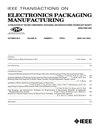Detection of Thermal Cycling-Induced Failures in RF/Microwave BGA Assemblies
IEEE Transactions on Electronics Packaging Manufacturing
Pub Date : 2008-07-09
DOI:10.1109/TEPM.2008.926289
引用次数: 26
Abstract
The purpose of this paper was to investigate the effect of thermal cycling on the high-frequency behavior of ball grid array (BGA) interconnection structures. In order to characterize the applicability of RF measurements in predicting interconnection breakdown, a broadband BGA transition structure between a radio frequency printed wiring board (RF-PWB) and a ceramic module was fabricated. In addition to basic assemblies consisting of two BGA transitions between the module and substrate, the designed transition was applied in a passband filter module to demonstrate the effect of thermal cycling on the performance of a practical device, as well. The BGA test modules mounted on the PWBs were exposed to thermal cycling testing over a temperature range of -40degC to + 125degC. To detect interconnection failures induced by cyclic thermal stresses, both dc resistance and scattering parameter measurements were performed on the test assemblies at specific intervals. Parallel to the electrical measurements, crack propagation in the vicinity of the BGA transition structure was investigated using scanning acoustic microscopy (SAM). Moreover, scanning electron microscopy (SEM) was used to determine the failure mechanisms of the test assemblies. Degradation of the signal transmission characteristics of the basic assemblies was first observed at higher microwave frequencies as an increase in signal return loss (|S11|) and/or a change in its phase. The effect of TCT on the filter assembly was more constant and clearer to observe in the phase than in the magnitude of S11 in the passband. The dc resistance measurements showed no indication of degradation in any of the tested assemblies.射频/微波BGA组件热循环失效检测
本文的目的是研究热循环对球栅阵列(BGA)互连结构高频性能的影响。为了表征射频测量在预测互连击穿中的适用性,制作了射频印刷线路板(RF- pwb)和陶瓷模块之间的宽带BGA过渡结构。除了由模块和衬底之间的两个BGA过渡组成的基本组件外,设计的过渡还应用于通带滤波器模块,以演示热循环对实际器件性能的影响。安装在pwb上的BGA测试模块在-40°c至+ 125°c的温度范围内进行热循环测试。为了检测由循环热应力引起的互连故障,在特定的间隔对测试组件进行了直流电阻和散射参数测量。在电测量的同时,利用扫描声显微镜(SAM)研究了BGA过渡结构附近的裂纹扩展。此外,利用扫描电子显微镜(SEM)分析了测试组件的失效机理。在较高的微波频率下,首先观察到基本组件的信号传输特性的退化,表现为信号回波损耗(|S11|)的增加和/或其相位的变化。TCT对滤波器组件的影响在相位上比在通带上的S11量级上更稳定,更清晰。直流电阻测量显示,在任何测试组件没有退化的迹象。
本文章由计算机程序翻译,如有差异,请以英文原文为准。
求助全文
约1分钟内获得全文
求助全文

 求助内容:
求助内容: 应助结果提醒方式:
应助结果提醒方式:


